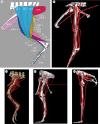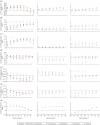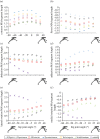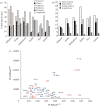Disparity and convergence in bipedal archosaur locomotion
- PMID: 22112652
- PMCID: PMC3350733
- DOI: 10.1098/rsif.2011.0687
Disparity and convergence in bipedal archosaur locomotion
Abstract
This study aims to investigate functional disparity in the locomotor apparatus of bipedal archosaurs. We use reconstructions of hindlimb myology of extant and extinct archosaurs to generate musculoskeletal biomechanical models to test hypothesized convergence between bipedal crocodile-line archosaurs and dinosaurs. Quantitative comparison of muscle leverage supports the inference that bipedal crocodile-line archosaurs and non-avian theropods had highly convergent hindlimb myology, suggesting similar muscular mechanics and neuromuscular control of locomotion. While these groups independently evolved similar musculoskeletal solutions to the challenges of parasagittally erect bipedalism, differences also clearly exist, particularly the distinct hip and crurotarsal ankle morphology characteristic of many pseudosuchian archosaurs. Furthermore, comparative analyses of muscle design in extant archosaurs reveal that muscular parameters such as size and architecture are more highly adapted or optimized for habitual locomotion than moment arms. The importance of these aspects of muscle design, which are not directly retrievable from fossils, warns against over-extrapolating the functional significance of anatomical convergences. Nevertheless, links identified between posture, muscle moments and neural control in archosaur locomotion suggest that functional interpretations of osteological changes in limb anatomy traditionally linked to postural evolution in Late Triassic archosaurs could be constrained through musculoskeletal modelling.
Figures







References
-
- Brusatte S. L., Benton M. J., Desojo J. B., Langer M. C. 2010. The higher-level phylogeny of Archosauria (Tetrapoda: Diapsida). J. System. Palaeontol. 8, 3–4710.1080/14772010903537732 (doi:10.1080/14772010903537732) - DOI - DOI
-
- Nesbitt S. J. 2011. The early evolution of archosaurs: relationships and the origin of major clades. Bull. Am. Mus. Nat. Hist. 352, 1–29210.1206/352.1 (doi:10.1206/352.1) - DOI - DOI
-
- Romer A. S. 1923. Crocodilian pelvic muscles and their avian and reptilian homologues. Bull. Am. Mus. Nat. Hist. 48, 533–552
-
- Romer A. S. 1923. The pelvic musculature of saurischian dinosaurs. Bull. Am. Mus. Nat. Hist. 48, 605–617
-
- Bakker R. T. 1971. Dinosaur physiology and the origin of mammals. Evolution 25, 636–65810.2307/2406945 (doi:10.2307/2406945) - DOI - DOI - PubMed
Publication types
MeSH terms
LinkOut - more resources
Full Text Sources
